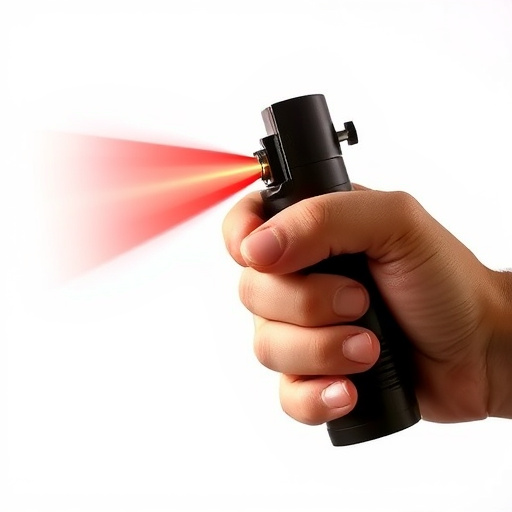Non-lethal pepper spray defense, featuring capsaicin-based oleoresin capsicum (OC) spray, offers a safe yet potent option for self-protection. It temporarily disrupts vision and breathing, providing escape time. With proper training, users can deploy it accurately, minimizing bystander harm while adhering to legal regulations regarding permits and usage. Despite environmental factors and repeat application needs, its quick effect makes it a popular personal defense mechanism.
“Uncover the power of non-lethal pepper spray as a defense tool in this comprehensive guide. We explore the science behind oleoresin capsicum spray, its effectiveness as a self-defense mechanism, and the legal framework surrounding its usage. From understanding the active ingredient to deciphering benefits and limitations, this article equips readers with knowledge on choosing and employing such tools responsibly. Navigate the world of non-lethal pepper spray defense and make informed decisions for your safety.”
- Understanding Non-Lethal Pepper Spray: A Comprehensive Overview
- How Oleoresin Capsicum Spray Works as a Defense Tool
- Legal Considerations and Usage Guidelines for Pepper Spray
- Benefits and Limitations of Using Pepper Spray for Self-Defense
Understanding Non-Lethal Pepper Spray: A Comprehensive Overview
Non-lethal pepper spray is a powerful yet safe defense tool designed to disable and incapacitate an assailant temporarily, providing individuals with time to escape dangerous situations. Unlike traditional pepper spray, which can cause severe respiratory distress or even blindness, non-lethal varieties use a controlled amount of capsaicin, the compound responsible for chili peppers’ heat, to induce discomfort and disorientation without causing permanent harm. This makes it an ideal self-defense option for people who want to protect themselves in public places or during outdoor activities.
The effectiveness of non-lethal pepper spray lies in its ability to disrupt the nerve signals between the eyes and the brain, leading to temporary blindness and a burning sensation. This disruption allows users to gain valuable time to retreat or call for help. With proper training and awareness, individuals can learn to use this tool responsibly, ensuring their safety without putting others at risk. Moreover, advancements in formulation have made modern non-lethal pepper sprays more accurate, easier to deploy, and less likely to cause accidental injuries, making them increasingly popular as personal defense mechanisms.
How Oleoresin Capsicum Spray Works as a Defense Tool
Oleoresin capsicum (OC) spray, often referred to as pepper spray, is a powerful non-lethal defense tool that disrupts an attacker’s vision and breathing, providing a crucial window for escape or intervention. When sprayed onto the skin or eyes, OC causes intense irritation, leading to temporary blindness and discomfort. This sensory overload disorientates the assailant, allowing the user to retreat safely or call for help.
The spray contains capsaicin, the compound that gives chili peppers their heat. When inhaled, capsaicin binds to receptors in the nose and eyes, triggering a chemical response that leads to tearing, itching, and a burning sensation. The effects typically peak within seconds and last anywhere from 15 minutes to an hour, ensuring the user has enough time to move to safety and seek assistance.
Legal Considerations and Usage Guidelines for Pepper Spray
In many jurisdictions, non-lethal pepper spray defense tools are regulated and their use is subject to strict legal considerations. It’s crucial to understand that while pepper spray can be an effective self-defense mechanism, it is not without restrictions. The legal implications vary across regions, with some countries permitting its use only for law enforcement or personal protection under specific circumstances. For civilian ownership, permits or licensing may be required, and there are often age restrictions and conditions regarding storage and transport.
Usage guidelines for pepper spray must be followed diligently to ensure safety and legality. This includes understanding the range and effect of the spray, as well as the responsibilities associated with carrying such a device. Users should be trained in its correct deployment, taking into account factors like wind direction and proximity to bystanders. Additionally, knowledge of local laws regarding when and where pepper spray can be used is essential to avoid legal repercussions.
Benefits and Limitations of Using Pepper Spray for Self-Defense
Pepper spray, a non-lethal self-defense tool, offers several advantages in potentially dangerous situations. Its primary benefit lies in its ability to incapacitate an assailant temporarily, providing users with time to escape or seek help. The active ingredient, capsaicin, triggers a burning sensation and causes respiratory distress, making it effective at keeping attackers at bay. This non-lethal pepper spray defense is particularly useful in close-quarters encounters where traditional self-defense options may not be readily available or practical.
However, there are limitations to consider. Pepper spray effectiveness can vary based on factors like wind, distance, and the assailant’s tolerance level. It may not always disable an attacker instantly, and repeat applications might be necessary in some cases. Additionally, pepper spray can have unintended consequences, such as causing temporary blindness or difficulty breathing for bystanders if not used responsibly. Despite these limitations, it remains a popular choice for personal protection due to its ease of use and rapid effect.
Oleoresin capsicum spray, a powerful yet non-lethal pepper spray, offers individuals an effective self-defense tool. Its unique properties disrupt an aggressor’s sensory perception, providing valuable time to escape dangerous situations. While legal considerations and usage guidelines vary, the benefits of this defense mechanism are undeniable. By understanding its mechanism of action, recognizing both advantages and limitations, and adhering to responsible usage practices, individuals can harness the power of non-lethal pepper spray for personal safety.
